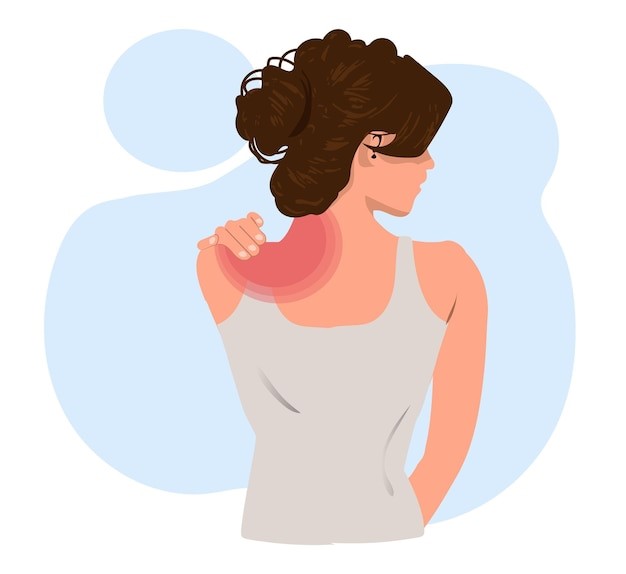
Since the emergence of the mobile internet era, where prolonged desk work, utilizing smartphones and laptops for both work and education, has become the standard for the majority of people, shoulder and neck discomfort has become a widespread issue. Many people assume they have frozen shoulder when the muscles surrounding the shoulders, particularly on the inner side of the shoulder blades, become weary and sore, and there is a sensation of compression in the shoulders, making simply lifting the hand difficult.
In fact, there are numerous causes of shoulder pain, and frozen shoulder is simply one of them.
Common causes of shoulder pain
1. Injuries caused by overuse
Long-term physical labour (such as carrying heavy objects or working with raised hands), frequent and excessive shoulder motions, repetitive shoulder injuries, and improper posture are all typical causes of shoulder pain.

These injuries are caused by the frequent repetition of a specific movement or posture, which causes the muscles and tissues around the shoulder to stiffen and strain over time. This can result in decreased muscle tissue functionality and the development of non-infectious inflammation, leading in shoulder pain.

Overuse shoulder pain often manifests as tight, aching muscles in the shoulder when in action, with relief happening after rest.
2. Injury to the Shoulder Joint
The shoulder joint is the most flexible joint in the body, with a range of motion of 360°. It is, nevertheless, one of the most vulnerable joints in our bodies, relying exclusively on tendons and muscles for protection. The shoulder joint, despite its flexibility, is not as stable as we may think. Overuse, inappropriate motions during physical activity, falls, or abrupt excessive force are all common causes of injury.

Patients with shoulder joint injuries may have redness and swelling around the joint, as well as pain, difficulties with regular arm movements, and joint misalignment or deformity. 。
3. Degeneration of the Joints
As we age, numerous functions in our bodies deteriorate, and our joints degenerate gradually over time. This can cause cartilage wear and tear, bone spurs (osteophytes), and joint stiffness. When the shoulder joint degenerates, the friction between the joint surfaces increases, causing the joint surface to become rough and and inflamed. This can diminish shoulder joint stability, promote muscular atrophy around the shoulder, and create pain.

Shoulder joint degeneration is characterized by joint swelling and chronic shoulder pain, particularly when executing specific actions or adopting certain postures. It may also disrupt daily tasks.
4. Synovitis and Tendonitis
Shoulder pain can also be caused by tendonitis or synovitis. Tendons are tissues that connect muscles to bones, supporting and stabilizing the shoulder joint. The synovium is the tissue that lines the inside of the shoulder joint and secretes synovial fluid to minimize friction during movement. 。Inflammation of the shoulder tendons and synovium can be caused by improper shoulder use, external traumas, and chronic inflammation.

Patients suffering from shoulder tendonitis and synovitis frequently experienceintense pain when moving the shoulder, particularly when lifting heavy objects or raising the arm, which can aggravate the shoulder pain. Tenderness and discomfort can also be caused by direct pressure on the tendons.
Characteristics of frozen shoulder
Adhesive Capsulitis, also known as Frozen Shoulder, typically affects people between the ages of 48 and 50 and is characterized by chronic inflammation of the muscle tissues surrounding the shoulder joint, resulting in adhesion of the shoulder capsule and shoulder stiffness, restricted mobility, and pain.

1. Frozen Shoulder is more common in those aged 48-50 and usually begins with pain in one shoulder. The symptoms manifest gradually.
2. Shoulder discomfort may be modestat first, and the site of the pain may be ambiguous, presenting as a dull and achy sensation. Over the time, the pain grows, especially at night, perhaps interfering with sleep. Tender spots around the shoulder joint may develop.
3. Patients’ shoulders may stiffen and lose range of motion, making it difficult to exert power or elevate, outwardly extend, or backwardly extend the arm.
Self-assessment for frozen shoulder
Frozen shoulder can be identified by a restricted range of motion in the shoulder joint. You can self-assess frozen shoulder by assessing your range of motion in your shoulder to rule out any problems. Here are some simple self-evaluation techniques:
1.Arm raise: Stand up straight and slowly raise your arm from underneath, aiming to get it near to your ear and above your head. Keep an eye out for any discomfort or notable limitations.

2.Arm abduction: Stand up straight and slowly stretch your arm upward and outward from your body, attempting to reach your arm near to your ear and above your head. Examine your movements for any signs of pain or restriction.

3.Arm Extension Behind Your Back: Place your back hand on your lower back and slowly raise your arm to touch the inside side of your opposite shoulder. Check for any discomfort or limitations.

Please keep in mind that these self-assessment methods are merely preliminary. If you suspect that you have frozen shoulder or are suffering shoulder problems, you should see a doctor for a thorough evaluation and diagnosis.
Clinical stages of Frozen Shoulder

Frozen shoulder is classified clinically into three stages:
1.Early Stage (Painful Phase):
- The pain in the shoulder is the most noticeable.
- Pain is frequently characterized as a burning sensation, and it is more severe at night.
- The range of motion in the shoulder joint starts to deteriorate.
2.Intermediate (Frozen Phase):
- The range of motion in the shoulder joint is severely limited.
- The ability of the shoulder joint to lift and extend backward rapidly deteriorates, making activities such as brushing teeth, combing hair, dressing and undressing difficult, and even putting on pants difficult.
3.Late Stage (Thawing Period):
- The pain in the shoulder joint eventually fades.
- Range of motion and functionality in the shoulder joint progressively return to normal.
Mastering the proper posture for using a computer and a mobile phone can help prevent shoulder and neck pain.

Guidelines for sitting properly while using a computer:
- Position the computer screen at or slightly below eye level, and use a monitor stand to get the right height while avoiding tilting your neck forward.
- Select a chair that is the proper height, with back support, and armrests. Allow your elbows to naturally dangle at a 90-degree angle on the armrests of your desk or chair.
- Sit in the chair with your bottoms filling the full seat and your back against the chair’s backrest to maintain an upright stance.
- Maintain a 90-degree angle with the floor by keeping both feet flat on the ground. Keep your legs from crossing. If you need to sit for an extended period of time, you can cross your legs at the ankles from time to time.
- Every hour, take a little pause to stand up, stretch your limbs, and move about.
Key points for the proper posture when using a mobile phone:
- Position of Standing
- When using a cell phone while standing, keep your head up, chest out, neck relaxed, and chin tucked in. Raise your phone so that your eyes are level with the phone screen.
- Hold the phone with both hands to prevent pressure on your fingers and wrists.
- Avoid using one hand to handle the phone, if possible unless it is absolutely required. In such instances, it is recommended that you use your other hand to support the elbow that is holding the phone, maintain upper body balance, and swap hand positions after 30 minutes of use.

- Posture While Sitting
- Maintain an adequate distance from the phone when using it while seated, ideally keeping the phone screen at the same eye level.
- Make sure your hands have a sturdy support surface, which you can achieve by resting your elbows on the desk.
- You can utilize tools like a phone stand to free up both hands, but be sure to position the stand to eye level height.

- Lying Position
- When using a cell phone while lying in bed, choose a flat laying position and avoid lying on your side.
- An ideal distance of between 30 and 50 centimetres should be maintained between the mobile phone screen and your eyes.
- You can relieve elbow pain by placing a blanket or cushion beneath your elbows.

此文章还有以下语言版本:
![]() 简体中文 (Chinese (Simplified))
简体中文 (Chinese (Simplified)) ![]() Melayu (Malay)
Melayu (Malay)



